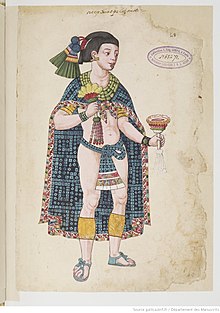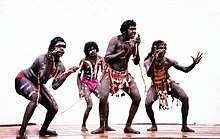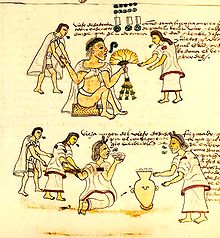Loincloth
This article needs additional citations for verification. (January 2012) |

A loincloth is a one-piece garment, either wrapped around itself or kept in place by a belt. It covers the genitals and, at least partially, the buttocks. Loincloths which are held up by belts or strings are specifically known as breechcloth or breechclout.[1][2] Often, the flaps hang down in front and back.[2]
History and types[]
Loincloths are worn in societies where no other clothing is needed or wanted. Loincloths are commonly used as an undergarment or swimsuit by wrestlers and by farmers in paddy fields in both Sri Lanka and India, where it is called Kovanam in Tamil, amudaya in Sinhala and kaupinam or langot.

The loincloth, or breechcloth, is a basic form of dress, often worn as the only garment. Men have worn a loincloth as a fundamental piece of clothing which covers their genitals, not the buttocks, in most societies which disapproved of genital nakedness throughout human history. The loincloth is in essence a piece of material, bark-bast, leather, or cloth, passed between the legs and covering the genitals. Despite its functional simplicity, the loincloth comes in many different forms.

The styles in which breechcloths and loincloths can be arranged are myriad. Both the Bornean sirat and the Indian dhoti have fabric pass between the legs to support a man's genitals.
A similar style of loincloth was also characteristic of ancient Mesoamerica. The male inhabitants of the area of modern Mexico wore a wound loincloth of woven fabric. One end of the loincloth was held up, the remainder passed between the thighs, wound about the waist, and secured in back by tucking.[Note 1]
In Pre-Columbian South America, ancient Inca men wore a strip of cloth between their legs held up by strings or tape as a belt. The cloth was secured to the tapes at the back and the front portion hung in front as an apron, always well ornamented.[citation needed] The same garment,[citation needed] mostly in plain cotton but whose aprons are now, like T-shirts, sometimes decorated with logos, is known in Japan as etchu fundoshi.
Some of the culturally diverse Amazonian indigenous still wear an ancestral type of loincloth.[citation needed]
Japanese men wore until recently[when?] a loincloth known as a fundoshi. The fundoshi is a 35-centimetre-wide (14 in) piece of fabric (cotton or silk) passed between the thighs and secured to cover the genitals.[citation needed]
Loincloths by culture[]
India[]
Unsewn Kaupinam and its later-era sewn variation langot are traditional clothes in India, worn as underwear in dangal held in akharas especially wrestling, to prevent hernias and hydrocele.[3] Kacchera is mandatory for Sikhs to wear.
Japan[]
Japanese men traditionally wore a loincloth known as a fundoshi. The fundoshi is a 35 cm (14 in.) wide piece of fabric (cotton or silk) passed between the thighs and secured to cover the genitals. There are many ways of tying the fundoshi.[4]
Native American[]

In most Native American tribes, men used to wear some form of breechcloth, often with leggings.[2][5][6][7] The style differed from tribe to tribe. In many tribes, the flaps hung down in front and back; in others, the breechcloth looped outside the belt and was tucked into the inside, for a more fitted look.[2] Sometimes, the breechcloth was much shorter and a decorated apron panel was attached in front and behind.[2]
A Native American woman or teenage girl might also wear a fitted breechcloth underneath her skirt, but not as outerwear. However, in many tribes young girls did wear breechcloths like the boys until they became old enough for skirts and dresses.[2] Among the Mohave people of the American Southwest, a breechcloth given to a young female symbolically recognizes her status as hwame.[8]
Philippines[]

In the Philippines, loincloths are generally known as bahag. It is a single piece of long rectangular cloth and is not tied with a belt or a string. They were commonly used by men throughout the pre-colonial Philippines. They were either made from barkcloth or from hand-woven textiles. Before the colonial period, bahag were a common garment for the commoners and servant class (the alipin caste).[9] It survives in some indigenous tribes of the Philippines today - most notably the Cordillerans in Northern Luzon.[10]
The specific way to wear it involves first pulling the long rectangular piece of cloth (usually around 2 to 3 m (6 ft 7 in to 9 ft 10 in)) in between the legs and covering the genitals, with a longer back part. The back part is then twisted across the right leg and across the waist in an anti-clockwise direction. It goes under the flap of the front part and across the left leg. It is twisted back across the back loop above the buttocks. The result resembles two rectangles of cloth hanging in front of and behind the waist, with a loop around the legs resembling a belt. The design of the weave is often unique to the tribe of the person wearing the bahag. The colors of the bahag can also indicate social status, with commoners usually wearing bahag in plain white.[11]
The native Tagalog word for "rainbow", bahaghari, literally means "loincloth of the king".[12]
Europe[]
Some European men around 2000 BCE wore leather breechcloths, as can be seen from the clothing of Ötzi.[13] Ancient Romans wore a type of loincloth known as a subligaculum.
The use of breechcloths took on common use by the Metis and Acadians and are mentioned as early as the 1650s. In the 1740s and 50s they were issued to the Canadien as part of their war uniform and in 1755 they even tried to issue them to soldiers from France.
"During their travels across Canada, the French [canadiens] dress as the Indians; they do not wear breeches" “Many nations imitate the French customs; yet I observed, on the contrary, that the French in Canada, in many respects, follow the customs of the Indians, with whom they converse everyday. They make use of the tobacco pipes, shoes, garters, and girdles of the Indians.” -Peter Kalm, 1749. "Those who go to war receive a capot, two cotton shirts, one breechclout, one pair of leggings, on blanket, one pair of souliers de boeuf, a wood-handled knife, a worm and a musket when they do not bring any. The breechclout is a piece of broadcloth draped between the thighs in the Native manner and with the two ends held by a belt. One wears it without breeches to walk more easily in the woods." – d’Aleyrac, 1755–60. “During the week the men went about in their homes dressed much like the Indians, namely, in stockings and shoes like theirs, with garters, and a girdle about the waist; otherwise the clothing was like that of other Frenchmen.” (Kalm, p. 558). "The French familiarized themselves with us, Studied our Tongue, and Manners, wore our Dress, Married our Daughters, and our Sons their Maids" (Pontiac, Ottawa leader, 2.2.50-57)
See also[]
- Similar Indian clothes
- Kacchera
- Langot
- Related Indian clothes
- Similar foreign clothes
- Breechcloth
- Fundoshi
- Loincloth
- Mawashi
- Perizoma
- Subligaculum
- Thong
- Perizoma (loincloth)
- Fundoshi
- Kaupinam
- Related foreign clothes
- Tallit katan
- Temple garment: religious undergarments worn by many Mormons
Notes[]
- ^ Local names: Nahuatl maxtlatl, Mayan ex.
References[]
- ^ U.S. National Park Service. Retrieved on 2009-12-22.
- ^ Jump up to: a b c d e f Native Languages Archived 2009-07-02 at the Wayback Machine. Retrieved on 2009-12-22.
- ^ Raman Das Mahatyagi (2007). Yatan Yoga: A Natural Guide to Health and Harmony. Yatan Ayurvedics. pp. 33–. ISBN 978-0-9803761-0-4.
- ^ "BOKUNAN-DO". www.shop-japan.co.jp.
- ^ Minor, Marz & Minor, Nono (1977). The American Indian Craft Book. Bison Books. pp. 72–73. ISBN 0-8032-5891-7. Google Book Search. Retrieved on 2010-07-15.
- ^ Mayfield, Thomas Jefferson (1997). Adopted by Indians: A True Story. Heyday Books. p. 83. ISBN 0-930588-93-2. Google Book Search. Retrieved on 2010-07-15.
- ^ Typical Indian Clothing (male). Retrieved on 2010-07-15.
- ^ Conner, Sparks, and Sparks, eds. (1997) Cassell's Encyclopedia of Queer Myth, Symbol, and Spirit: Covering Gay, Lesbian, Bisexual, and Transgender Lore
- ^ Lopez, Mellie Leandicho (2006). A Handbook of Philippine Folklore. UP Press. p. 385. ISBN 9789715425148.
- ^ Dalton, David; Keeling, Stephen (2013). The Rough Guide to the Philippines. Rough Guides UK. ISBN 9781405392075.
- ^ Belen, Yvonne (21 June 2014). "Loincloth (G-string, Bahag)". Grand Cañao. Retrieved 21 July 2021.
- ^ "Glossary of Confusing Pinoy Expressions". Spot.ph. 10 October 2013. Retrieved 21 July 2021.
- ^ South Tyrol Museum of Archaeology. Retrieved 2010-07-15.
External links[]
| Wikimedia Commons has media related to Loincloths. |
- Indian clothing
- Maya clothing
- Polynesian clothing
- Skirts
- Swimsuits
- Undergarments
